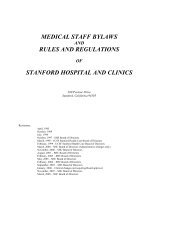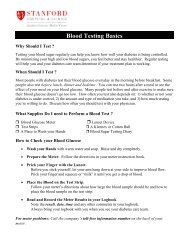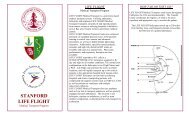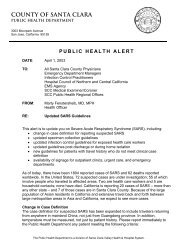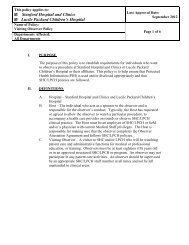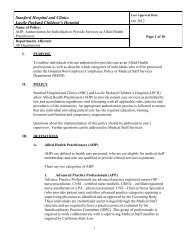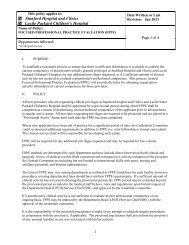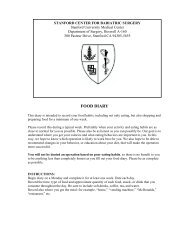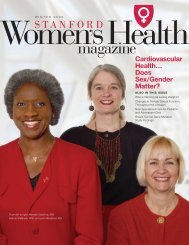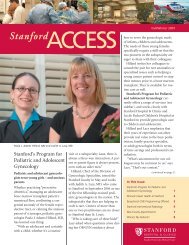rEdEFInIng - Stanford Hospital & Clinics
rEdEFInIng - Stanford Hospital & Clinics
rEdEFInIng - Stanford Hospital & Clinics
Create successful ePaper yourself
Turn your PDF publications into a flip-book with our unique Google optimized e-Paper software.
YEAR IN REVIEW<br />
redefining possible<br />
WHAT’S
Polly Weinheimer<br />
Oncology Patient P2»<br />
Michael Moore<br />
Transplant and Cardiology Patient P4»<br />
Eugene Lee<br />
Cardiovascular Patient P6»<br />
TABLE<br />
contents<br />
OF<br />
We are very grateful to these patients and<br />
their families for allowing us to share their<br />
personal stories with you.<br />
Dr. Rachael Callcut<br />
Trauma/Critical Care Surgeon P 12»<br />
Sandi Wearing<br />
Neurology Patient P8»<br />
Melanie Murphy<br />
Sports Medicine Patient P 10»<br />
Advancing Technology & Innovation<br />
Room 9: Hybrid Healthcare P 15»<br />
The New <strong>Stanford</strong> <strong>Hospital</strong><br />
Atrium View P 18»<br />
The Corporate Partners Program<br />
Six Silicon Valley Companies P 20»<br />
Letter from Mariann Byerwalter<br />
Chair, Board of Directors P1»<br />
Letter from Amir Dan Rubin<br />
President & CEO P1»<br />
Buzz and Peg Gitelson<br />
<strong>Stanford</strong> <strong>Hospital</strong> Partners P 16»<br />
The Byers Eye Institute at <strong>Stanford</strong><br />
Opened September 2010 P 21»<br />
Chuck Horngren<br />
Horngren Family Vitreoretinal Center P 21»
Mariann Byerwalter<br />
Chair, Board of Directors<br />
<strong>Stanford</strong> <strong>Hospital</strong> & <strong>Clinics</strong><br />
HEALIng P<br />
humanity<br />
science<br />
oNE PATIENT AT A TImE<br />
<strong>rEdEFInIng</strong> WHAT Is POssIBLE<br />
On behalf of the <strong>Stanford</strong> <strong>Hospital</strong> & <strong>Clinics</strong> Board of Directors, I am pleased<br />
to share this overview of an exciting year.<br />
First, we welcomed our new CEO, Amir Dan Rubin, who is the leader we<br />
envisioned for this historic moment in our history—a proven healthcare executive<br />
with a deep personal commitment to innovation in all aspects of health care,<br />
extensive knowledge of academic medical centers, and dedication to patientcentered<br />
clinical environments.<br />
Second, we launched an unprecedented new collaboration with leading Silicon<br />
Valley companies that are generously supporting development of the New <strong>Stanford</strong><br />
<strong>Hospital</strong>, as described on page 20. The need to replace our 1950s-era building<br />
with modern, seismically safe, technologically advanced facilities commensurate<br />
with <strong>Stanford</strong>’s outstanding medical care is critical. Even more important, it has<br />
presented us with a transformative opportunity that comes only once in a generation.<br />
Our Board of Directors, executive team and <strong>Stanford</strong> faculty physician leaders are<br />
united in our commitment to realize a dream that even a decade ago would have<br />
seemed impossible. The New <strong>Stanford</strong> <strong>Hospital</strong> will enable us to harness the power<br />
of technology to improve outcomes for patients and control costs; find previously<br />
unimagined methods of prevention, diagnosis and treatment; and achieve<br />
breakthroughs in patient experience. Our new hospital facility is key to fulfilling this<br />
vision, and it is attracting exceptional leadership and generosity at every level.<br />
I want to thank everyone whose contributions helped make this another outstanding<br />
year in <strong>Stanford</strong> <strong>Hospital</strong>’s long and distinguished history. Your support benefits<br />
patients worldwide while ensuring that each patient here continues to receive the<br />
full benefit of <strong>Stanford</strong>’s unmatched excellence in teaching, research and clinical<br />
care. We are truly grateful and hope that the stories in these pages will inspire you,<br />
just as they have inspired us to reach even higher and redefine what is possible.<br />
Return to TOC<br />
THrOUgH<br />
ImPrOvIng HEALTH And HEALTH cArE<br />
Since arriving at <strong>Stanford</strong>, I’ve often been asked what should be the strategy for our<br />
hospital and clinics. At some level, the answer is simple—to ensure that the next<br />
patient who walks in the door receives the absolute best in care, incorporating the<br />
latest innovations, at the highest level of quality, delivered with genuine compassion<br />
and an outstanding patient experience.<br />
Our goal is to achieve this for every patient, every time, and we are actively working<br />
to make this possible. The moving stories featured in these pages are examples of<br />
the difference <strong>Stanford</strong> <strong>Hospital</strong> & <strong>Clinics</strong> makes in the lives of thousands every year.<br />
We are very grateful to these six patients and their families for allowing us to share<br />
their personal stories with you.<br />
<strong>Stanford</strong> <strong>Hospital</strong> & <strong>Clinics</strong> is uniquely positioned to improve health and health<br />
care, both around the globe and for our local community. As we continue to lead<br />
in developing breakthrough treatments that will benefit patients everywhere, we take<br />
great pride in being able to offer them first to patients here. We are reminded every<br />
day that the next person who entrusts us with his or her care—whether a family<br />
member, friend, neighbor or international visitor—is our most important patient and<br />
has our full commitment.<br />
This report highlights major initiatives under way that promise a future of limitless<br />
opportunity—from building the most patient-centered and technologically advanced<br />
new hospital in the world, to ensuring that every patient encounter is exemplary,<br />
to partnering with some of the most innovative Silicon Valley companies in new<br />
ways—all with the goal of healing humanity through science, one patient at a time.<br />
<strong>Stanford</strong> has the people, expertise, commitment and vision to fully achieve this<br />
transformative potential in the years ahead. It is a privilege for me to join such<br />
a talented and dedicated group of physicians, nurses, clinicians, staff and<br />
administrators to serve this remarkable community.<br />
Amir Dan Rubin<br />
President & CEO<br />
<strong>Stanford</strong> <strong>Hospital</strong> & <strong>Clinics</strong><br />
1
oNCoLoGY<br />
STANfoRd WomEN’S CANCER CENTER<br />
In the summer of 2011, the <strong>Stanford</strong> Women’s Cancer Center will open<br />
its doors. The Center will considerably enlarge the current clinical space<br />
dedicated to the treatment of women with breast and gynecologic cancers,<br />
providing individualized and compassionate care for the whole patient.<br />
The Women’s Cancer Center will begin each woman’s journey toward<br />
survivorship with concierge services to help her navigate and manage her<br />
treatment. Support groups for patients and family members will be part of<br />
a care package that includes counseling, palliative care, survivorship<br />
services and more. In an atmosphere with warmth and welcome at its core,<br />
founded upon the advanced clinical trials and ground-breaking translational<br />
research for which <strong>Stanford</strong> is known, the Women’s Cancer Center programs<br />
will feature an integrative healing approach to strengthen the body, educate<br />
the mind and nurture the spirit.<br />
2<br />
better<br />
JuST STEPS FROM THE STANFORD CANCER<br />
CENTER, THE NEW STANFORD WOMEN’S CANCER<br />
CENTER WIll PROVIDE RESOuRCES, SuPPORT<br />
AND ExPERTISE TO WOMEN WITH BREAST AND<br />
gYNECOlOgIC CANCERS.<br />
Return to TOC<br />
options FOr mOrE PATIEnTs<br />
“Thanks to innovations and new treatment<br />
methods, we can really offer a more positive<br />
experience to nearly every person we treat.”<br />
Dr. Frederick Dirbas<br />
Breast Cancer Surgeon<br />
With no family history of cancer, Polly Weinheimer was<br />
surprised when, after a routine check-up in 2002, her<br />
doctor advised her to contact <strong>Stanford</strong> cancer surgeon<br />
Dr. Frederick Dirbas for a breast cancer consultation.<br />
“Many patients fear the worst when they receive a cancer<br />
diagnosis,” says Dr. Dirbas. “But thanks to innovations and<br />
new treatment methods, we can really offer a more positive<br />
message and experience to nearly every person we treat.”<br />
Cancer therapies that were once brutally invasive have<br />
evolved. Depending on the size and location of a tumor,<br />
lumpectomies, improved chemotherapy and more targeted<br />
radiation have all eased the treatment burden for patients.<br />
Dr. Dirbas told Polly she was a prime candidate for<br />
intraoperative radiation therapy (IORT), a new protocol<br />
to treat the size of tumor she had. When her tumor was<br />
removed, radiation treatment was sent directly into the<br />
tissue surrounding the tumor at the time of the surgery.<br />
The single treatment replaced six weeks of daily radiation<br />
after surgery. Dr. Dirbas was one of just a handful of<br />
physicians, and <strong>Stanford</strong> <strong>Hospital</strong> one of a similarly<br />
small group of hospitals, to offer IORT for breast cancer<br />
at that time.<br />
Instead of enduring the exhaustion and discomfort that are<br />
common side effects of multiple radiation sessions, Polly<br />
went home and got back to her life. Today, nearly a decade<br />
after her treatment, she is 70 years old and still enjoying her<br />
favorite hiking trails.<br />
3
TRANSPLANT ANd CARdIoLoGY<br />
In 2007, Michael Moore found himself balanced precariously<br />
between a rock and a hard place. While undergoing a<br />
comprehensive screening for the liver transplant he needed,<br />
he learned that he also had a hole in his aortic valve. The<br />
news was devastating. With a failing heart, he couldn’t get<br />
a liver transplant. And his liver condition meant that heart<br />
repair would be too dangerous. Michael’s medical team<br />
didn’t shrink from the challenge. “<strong>Stanford</strong> has the drive<br />
to provide excellent care for everyone,” says Dr. Tami<br />
Daugherty, Michael’s transplant hepatologist. “There’s<br />
no ‘We can’t do it’ here.”<br />
Michael’s treatment brought together a multidisciplinary<br />
team of physicians to perform a rare combined procedure.<br />
Once a liver became available, the <strong>Stanford</strong> transplant and<br />
cardiothoracic teams worked for 17 hours to repair Michael’s<br />
heart and replace his liver. While recovering from his surgery,<br />
Michael was visited by the large team of professionals<br />
who had made his operation a success. He was excited<br />
to meet not just his surgeons, but also the extended group<br />
of physicians who were able to learn from his unusual case.<br />
“Not only did I have a fleet of the best doctors,” says Michael,<br />
“but the next generation was there, also learning from the<br />
best.” Now more than three years later, Michael’s eyes twinkle<br />
with fun, and he’s learning how to play the guitar, something<br />
he’s always wanted to do.<br />
expanding<br />
the TEAM<br />
overcome<br />
TO<br />
cHALLEngEs<br />
4 Return to TOC<br />
5<br />
EVERY lIVER TRANSPlANT PATIENT IS uNIquE.<br />
DR. TAMI DAugHERTY REVIEWS EACH<br />
PERSON’S NEEDS WITH AN INTERDISCIPlINARY<br />
TEAM OF STANFORD PHYSICIANS, NuRSES<br />
AND TRANSPlANT COORDINATORS.<br />
GIVING THE GIfT of LIfE<br />
Waiting lists for liver donations are notoriously long in the<br />
Bay Area, and many patients in need cannot survive the<br />
wait time for a deceased-donor liver. Today, more patients<br />
and their families are exploring the option of living donor<br />
liver transplantation (lDlT), a promising alternative for liver<br />
transplant patients. With lDlT, living donors give a portion<br />
of their healthy liver to needy recipients, decreasing the<br />
wait time to transplantation and improving patient survival<br />
rates. Organ donation is an altruistic gift, and each living<br />
donor candidate is evaluated by an independent living donor<br />
advocate to ensure donor safety, informed consent and lack<br />
of coercion. At <strong>Stanford</strong> <strong>Hospital</strong> & <strong>Clinics</strong>, people who choose<br />
to donate through lDlT undergo a thorough evaluation and<br />
screening process and are treated with the same high caliber<br />
of care as transplant recipients.<br />
“Not only did I have a fleet<br />
of the best doctors, but the<br />
next generation was there,<br />
also learning from the best.”<br />
Michael Moore<br />
Transplant and Cardiology Patient
CARdIoVASCULAR<br />
CREATINg A PlAN<br />
to<br />
exceed<br />
6<br />
ESSENTIAl FOR lIFE, THE CIRCulATORY<br />
SYSTEM IS A POWERFul NETWORk OF<br />
BlOOD VESSElS THAT DElIVERS OxYgEN<br />
AND NuTRIENTS, FIgHTS INFECTION AND<br />
REMOVES WASTE FROM THE BODY.<br />
expectations<br />
Return to TOC<br />
mEETING ComPLEx CHALLENGES<br />
At <strong>Stanford</strong> <strong>Hospital</strong> & <strong>Clinics</strong>, vascular surgeons receive<br />
the most difficult cases from around the Bay Area because<br />
they have the experience, equipment and expertise to<br />
give people better odds for a positive outcome. Vascular<br />
patients like Eugene benefit significantly from recent<br />
technological breakthroughs, many pioneered at <strong>Stanford</strong>,<br />
including high-speed CT and MRI angiography and 3D image<br />
reconstruction technologies that give surgeons detailed<br />
information about what is happening in the vascular<br />
system. Another <strong>Stanford</strong> strength is minimally invasive,<br />
or endovascular, techniques to repair aortic aneurysms.<br />
These techniques employ a catheter threaded into the body<br />
through a small incision and have reduced the risk of death<br />
during surgical repair by more than 50 percent.<br />
When 60-year-old Eugene lee arrived at his local hospital<br />
after his right leg buckled beneath him, he was given<br />
some disturbing news. “They wanted to amputate my leg,”<br />
says Eugene, recalling the verdict that left him and his wife<br />
shaken. Eugene needed a higher degree of care, so he<br />
was transferred to <strong>Stanford</strong> <strong>Hospital</strong>.<br />
A survey of Eugene’s circulatory system showed <strong>Stanford</strong>’s<br />
vascular specialists that in addition to the aneurysm<br />
threatening his right leg, he also had an aneurysm in his left<br />
leg and blockage in his carotid artery. And Eugene wasn’t<br />
just at risk of losing a limb. Another aneurysm in his abdomen<br />
had swollen his aorta, and it looked ready to rupture. When an<br />
aneurysm ruptures in the aorta, the main vessel routing blood<br />
from the heart to the rest of the body, fatal effects can be just<br />
minutes away.<br />
“Multiple aneurysms are not uncommon,” says Dr. Ronald<br />
Dalman, the <strong>Stanford</strong> vascular surgeon who received<br />
Eugene’s transfer. “When you have four or five problems,<br />
it’s about setting priorities and figuring out the best sequence<br />
of treatment. What you need is a coherent plan.” Repairing<br />
Eugene’s aortic aneurysm became the first priority for<br />
Dr. Dalman and his team. Initial surgery stabilized Eugene’s<br />
abdominal aorta, and subsequent revascularization<br />
procedures restored blood flow to Eugene’s legs and repaired<br />
his carotid artery. Eugene’s leg—and his life—were saved.<br />
“I was lucky,” says Eugene. “I was at the right hospital with<br />
the right doctor.”<br />
“I was lucky. I was at the right<br />
hospital with the right doctor.”<br />
Eugene Lee<br />
Cardiovascular Patient<br />
7
NEURoLoGY<br />
A BETTER WAY To do IT<br />
Surgery of any kind near the brain stem carries precipitous risks of damage<br />
with catastrophic consequences. Traditionally, neurosurgeons have taken<br />
their instruments to that area only through the mouth or the side of the neck,<br />
although both approaches risk adverse effects on swallowing, breathing and<br />
speech, and require a long recovery. Surgeries that go through the nasal<br />
passages to the eye and the brain have been possible only in the last decade<br />
or so. New imaging technologies and new, extended surgical tools are more<br />
flexible, optically sharper and much, much smaller. At <strong>Stanford</strong> <strong>Hospital</strong>,<br />
endonasal surgery is thriving, with vibrant collaborations between the<br />
Neurosurgery and Otolaryngology Departments.<br />
8<br />
forging<br />
DR. STEFAN MINDEA HAS PIONEERED NEW<br />
TECHNIquES TO DECREASE RISk DuRINg<br />
BRAIN AND SPINAl SuRgERY WHIlE INCREASINg<br />
PATIENT COMFORT THROugHOuT RECOVERY.<br />
Return to TOC<br />
nEW<br />
pathsTO<br />
SuCCESS<br />
“This surgery meant going home sooner<br />
and with much less pain and fewer risks<br />
of complications.”<br />
Dr. Stefan Mindea<br />
Director of the Neurosurgery Department’s<br />
Minimally Invasive Spinal Surgery Program<br />
Sandi Wearing’s MRI showed a mass at the very top<br />
of her spinal column, providing one possible explanation<br />
for what was making her speech difficult and her arms<br />
weak. At <strong>Stanford</strong>, Sandi found two physician-scientists,<br />
Dr. Stefan Mindea and Dr. Jayakar Nayak, who would<br />
save her speech with an advanced surgical procedure that<br />
reached her spine through her nose and sinuses. Never<br />
before done at <strong>Stanford</strong>, the endonasal odontoidectomy<br />
is a rarely performed procedure. There are just a handful<br />
of medical centers anywhere that can accomplish this level<br />
of endonasal surgery.<br />
A chance meeting in the faculty lounge brought together<br />
Sandi’s surgeons—Dr. Mindea, Director of the Neurosurgery<br />
Department’s Minimally Invasive Spinal Surgery Program, and<br />
Dr. Nayak, Co-director of the Otolaryngology Department’s<br />
<strong>Stanford</strong> Sinus Center. Dr. Mindea was frustrated with the<br />
surgical routes typically used to reach the spine through the<br />
mouth or neck. Dr. Nayak, who regularly performs transnasal<br />
sinus and skullbase surgery, knew how to reach the spine<br />
through the nasal cavity. “For the right patient, you can<br />
get to a site of interest with much less pain and dissection<br />
through normal tissues,” says Dr. Nayak.<br />
With a new path identified, Dr. Mindea was confident he<br />
could cut down his patient’s recovery time and increase<br />
her comfort. “This surgery meant going home sooner and<br />
with much less pain and fewer risks of complications,”<br />
he says. The successful surgery safely removed the mass.<br />
Sandi has been speaking confidently and using her arms<br />
freely ever since.<br />
9
SPoRTS mEdICINE<br />
Basketball player Melanie Murphy came blazing out of<br />
Brooklyn as a point guard with the kinds of steals, assists,<br />
blocks and grade-point average that made her a natural for<br />
the <strong>Stanford</strong> university women’s team. In her freshman year,<br />
Melanie played in 31 games as the Cardinal took on its<br />
tough Pac-10 Conference competitors. The next year was<br />
not so good.<br />
During her second season, Melanie tore her left knee’s<br />
anterior cruciate ligament (ACl), a common injury for athletes<br />
of her caliber. The season-ending injury sent her to see<br />
Dr. Marc Safran, a physician for many collegiate teams and<br />
the Associate Chief of Sports Medicine at <strong>Stanford</strong> <strong>Hospital</strong> &<br />
<strong>Clinics</strong>. Repairing Melanie’s left ACl was a straightforward<br />
surgery, and after several months of rehab she was playing<br />
again. But just as her athletic life was getting back on track,<br />
a new injury threatened her right knee the very next year.<br />
Coincidentally, Dr. Safran was studying articular cartilage<br />
damage in basketball players at that time, using an MRI with<br />
a special cartilage sequencing image function to examine for<br />
both structural damage and more subtle cartilage changes<br />
that could cause problems later. Based on a scan of her new<br />
injury, Dr. Safran recommended a second surgery.<br />
While some players might have abandoned their sports<br />
dreams in the face of yet another surgery, Melanie was<br />
confident that Dr. Safran and his team would provide excellent<br />
care. “They are very in tune with what athletes need. They<br />
have a lot of experience,” she says. Melanie had the second<br />
surgery and returned to play, helping bring the Cardinal<br />
one more Pac-10 championship. Her care gave her not only<br />
another season, but the chance for a life without knee<br />
restrictions or pain.<br />
“They are very in tune with what<br />
athletes need. They have a lot<br />
of experience.”<br />
Melanie Murphy<br />
Orthopaedic Surgery Patient<br />
THE ACl IS ONE OF THE MOST COMMON<br />
lIgAMENTS TO BE INJuRED. IT CAN BE<br />
STRETCHED AND/OR TORN DuRINg A<br />
SuDDEN TWISTINg MOTION WHEN THE<br />
FEET STAY PlANTED ONE WAY, BuT THE<br />
kNEES TuRN THE OTHER WAY.<br />
renewed<br />
CONFIDENCE<br />
THAT gIvEs ATHLETEs<br />
experience<br />
10 Return to TOC<br />
11
GENERAL SURGERY<br />
ExPERIENCE THAT mAkES THE dIffERENCE<br />
In the emergency room, patients’ chances of survival come down to the<br />
extent of their injuries, the timeliness of their treatment and the degree of<br />
technical expertise their trauma surgeon brings. <strong>Stanford</strong> <strong>Hospital</strong> is the<br />
only level 1 Trauma Center between San Francisco and San Jose—and<br />
one of the few in the country to receive a flawless report from the American<br />
College of Surgeons’ Committee on Trauma. Patients taken to a trauma<br />
center after serious injury have a 20–25 percent greater chance of survival,<br />
and for more than 40 years, the ED at <strong>Stanford</strong> <strong>Hospital</strong> has served all<br />
South Peninsula residents.<br />
12<br />
WITH MORE THAN 50,000 VISITS EACH YEAR, THE<br />
STANFORD HOSPITAl EMERgENCY DEPARTMENT’S<br />
PATIENT ADMITTINg REPRESENTATIVES, uNIT<br />
SECRETARIES AND VOluNTEERS ARE AlWAYS<br />
ON HAND TO MEET THE COMMuNITY’S NEEDS.<br />
Return to TOC<br />
steady hands<br />
WHEn<br />
minute<br />
EvErY<br />
cOUnTs<br />
“You have to be calm and level-headed in<br />
what by nature is chaos, and time is never<br />
on our side.”<br />
Dr. Rachael Callcut<br />
Surgeon<br />
Trauma/Critical Care<br />
What is it like to work as a general surgeon in the Emergency<br />
Department? “You have to be calm and level-headed in what<br />
by nature is chaos, and time is never on our side,” answers<br />
Dr. Rachael Callcut, trauma surgeon at <strong>Stanford</strong> <strong>Hospital</strong> &<br />
<strong>Clinics</strong>. Jose Hernandez learned just how important taming<br />
that chaos is when he was rushed to <strong>Stanford</strong> <strong>Hospital</strong>’s<br />
Emergency Department after a head-on collision on the<br />
Dumbarton Bridge.<br />
Though the healthy 22-year-old never lost consciousness,<br />
Dr. Callcut knew he was in serious danger. His vital signs<br />
were initially not out of the ordinary, but his complaints<br />
of abdominal pain and his pallor suggested that he was<br />
bleeding. As soon as Dr. Callcut moved the wand of a<br />
portable ultrasound across his body, she could pinpoint<br />
the problem—about a third of Jose’s blood had poured<br />
out into his abdomen.<br />
“Time was running out quickly,” says Dr. Callcut. “In another<br />
15 minutes, Jose would have bled to death.” Within five<br />
minutes of arriving at the hospital, Jose was on his way to<br />
surgery, where Dr. Callcut and others quickly sewed up<br />
his most crucial wounds, keeping Jose alive long enough<br />
to treat his less serious injuries.<br />
When Jose came to several days after his surgeries, he took<br />
stock of his life. “laying in bed there,” he says, “I started<br />
appreciating what had happened to me, and believing that<br />
god exists.” Jose has since made a full recovery, and enjoys<br />
spending time with his wife and baby daughter.<br />
13
Dr. Kevin Tabb<br />
Chief Medical Officer<br />
<strong>Stanford</strong> <strong>Hospital</strong> & <strong>Clinics</strong><br />
AdvAncIng<br />
RECOGNITION FOR STANFORD HOSPITAL & CLINICS<br />
U.S. News & World Report<br />
U.S. News & World Report has ranked us the #1 hospital<br />
in San Jose, California, in its first-ever Best <strong>Hospital</strong>s Metro<br />
Area rankings.<br />
leapfrog group<br />
Our top hospital designation from the leapfrog group recognizes<br />
our accomplishments in preventing medication errors, exceeding<br />
standards for high-risk procedures and increasing patient safety.<br />
A nEW ErA In mEdIcInE<br />
technology<br />
and<br />
innov<br />
As our nation’s focus on the exciting potential for electronic medical records to advance<br />
health care continues, <strong>Stanford</strong> <strong>Hospital</strong> & <strong>Clinics</strong> is proud to be at the forefront of this<br />
new era in medicine. last year, we became one of a handful of institutions nationwide<br />
to receive the highest-level designation for our electronic medical record system. This<br />
year we began to explore how having this capability will improve patient outcomes,<br />
increase safety and help manage costs.<br />
We now have the tools to actually do what in the past could only have been imagined.<br />
Within each patient’s electronic medical record is a treasure trove of information. When<br />
combined with similar information about thousands of other individuals, it will provide<br />
us with insights about how to deliver better care and ensure that resources are being<br />
used effectively and efficiently.<br />
Our challenge is to turn this invaluable data into meaningful information. until now,<br />
patient data was in millions of pages of paper files, inaccessible on an aggregate<br />
basis to researchers. <strong>Stanford</strong> is uniquely positioned to lead the new era of discovery<br />
made possible by electronic data, drawing upon the expertise of our physician faculty<br />
at the <strong>Stanford</strong> School of Medicine, our innovation partners in Silicon Valley and the<br />
unmatched interdisciplinary resources of <strong>Stanford</strong> university.<br />
We know, for example, that it is important to follow clinical guidelines in health care,<br />
yet it is a challenge for hospitals everywhere to take national guidelines and use them<br />
consistently to improve care. By analyzing the extensive data in electronic medical<br />
records, we will be able to determine with much greater clarity where we are doing<br />
well, where we need to do better and where to make necessary changes rapidly.<br />
Never before in the history of medicine has this been possible, and <strong>Stanford</strong> <strong>Hospital</strong><br />
is one of only a few institutions that will be doing this soon.<br />
The quality of care we provide to our patients is already at the highest level—as evident<br />
in the awards and recognition that <strong>Stanford</strong> <strong>Hospital</strong> & <strong>Clinics</strong> continues to receive<br />
from the leapfrog <strong>Hospital</strong> Survey, the American Nurses Credentialing Center Magnet<br />
designation, U.S. News & World Report and many others. Today we are poised to reach<br />
even higher goals on behalf of our patients and to achieve the full potential of electronic<br />
medical records for patients here and around the world.<br />
American Nurses Credentialing Center<br />
We are among only 6 percent of all healthcare organizations in<br />
the u.S. to achieve the ANCC Magnet Recognition ® status based<br />
on quality patient care, nursing excellence and innovations in<br />
professional nursing practice.<br />
Healthcare Information and Management Systems Society<br />
We received the highest level designation for our electronic medical<br />
record system from the leading healthcare IT industry group, HIMSS.<br />
<strong>Stanford</strong> <strong>Hospital</strong> was the fourth healthcare organization in the nation<br />
to achieve top-level designation, known as “Stage 7.”<br />
ation<br />
TO AcHIEvE THE<br />
HIgHEsT-QUALITY cArE<br />
YOUr mEdIcAL InFOrmATIOn<br />
AT YOUr FIngErTIPs<br />
In December 2010, <strong>Stanford</strong> <strong>Hospital</strong> & <strong>Clinics</strong> launched<br />
MyHealth, a tool that helps patients and their physicians<br />
make digital health records a more useful part of everyday<br />
care. “We were looking for a tool that would help patients<br />
interact with us in a meaningful way,” says Dr. Christopher<br />
Sharp, an internist and lead physician advocate for the<br />
MyHealth system.<br />
The Web-based system enhances the doctor-patient<br />
relationship by increasing access to clinics and providing<br />
timely, secure information about a patient’s medical care.<br />
using MyHealth, <strong>Stanford</strong> patients can see health information<br />
such as test results, keep track of upcoming appointments<br />
and send secure messages to their clinics if they have<br />
questions or concerns. In its first month, more than 2,300<br />
messages were sent to clinics, and more than 16,000 patients<br />
have taken advantage of the program so far.<br />
Room 9: A nEW sTAgE FOr<br />
HYBrId HEALTH cArE<br />
It used to be standard operating procedure for a neurosurgery patient to<br />
travel quite a distance inside the hospital. Diagnostic imaging, microscopic<br />
monitoring and surgical interventions were not in one place, requiring full<br />
operating teams, as well as their patients, to move from room to room.<br />
That was before Room 9.<br />
Designed specifically to allow on-scene collaboration between specialists<br />
in neurosurgery and neuroradiology, Room 9 is 800 square feet of hybrid<br />
capability. It is large enough to house state-of-the-art imaging equipment,<br />
space for surgery and room to accommodate any extra medical professionals<br />
who might be needed in an unanticipated turn of events. In Room 9, daylong<br />
neurological procedures have been reduced to only four hours, and patients<br />
face fewer risks from movement and less exposure to radiation for imaging.<br />
Building on the success of Room 9, the New <strong>Stanford</strong> <strong>Hospital</strong> will include<br />
one entire floor of this kind of multipurpose space, with several 1,000-squarefoot<br />
units large enough to accommodate larger-scale equipment and more<br />
people. “We are convinced that new hybrid rooms are what is needed at<br />
<strong>Stanford</strong>, so it makes sense to invest the effort and funds to make it happen,”<br />
says Jerry Maki, the <strong>Hospital</strong>’s Vice President of Clinical Services.<br />
14 Return to TOC<br />
15
THE<br />
16<br />
POWEr<br />
of<br />
philanthropy<br />
From its earliest days, <strong>Stanford</strong> <strong>Hospital</strong> has been empowered<br />
by generous, visionary people who share its mission. Today,<br />
this is more true than ever. In fiscal year 2010, 4,550 donors<br />
from our local community and around the world gave more<br />
than $18 million to improve patient care; upgrade our physical<br />
plant; buy equipment; invest in technology; add art, music and<br />
gardens to the hospital; and make sure that patients, families,<br />
visitors and staff have the support and services they need.<br />
A listing of our generous friends can be found on page 22.<br />
As we look to the future, and what the 21st century demands,<br />
private giving remains essential to our core mission.<br />
Return to TOC<br />
“We are so thankful to have<br />
this kind of care available<br />
literally across the street.<br />
Whatever we can do to help,<br />
we’re going to do.”<br />
Buzz Gitelson<br />
<strong>Stanford</strong> Cancer Center Patient<br />
sTAnFOrd HOsPITAL PArTnErs<br />
<strong>Hospital</strong> Partners help keep <strong>Stanford</strong> at the leading edge<br />
of medical care. These flexible, unrestricted funds allow the<br />
<strong>Hospital</strong> to pursue innovations, meet unanticipated needs<br />
and quickly take advantage of any possibility that promises<br />
to improve patient care. To acknowledge and honor their<br />
contributions, we invite our <strong>Hospital</strong> Partners to attend regular<br />
events, lectures and other programs designed to keep them<br />
informed about <strong>Stanford</strong> Medicine. last year, 2,045 <strong>Stanford</strong><br />
<strong>Hospital</strong> Partners donors made gifts totaling $1,225,461.<br />
LEgAcY PArTnErs<br />
The legacy Partners Program honors those who serve<br />
future generations of <strong>Stanford</strong> <strong>Hospital</strong> patients with gifts<br />
made through their estate or trust plan. A gift to legacy<br />
Partners combines philanthropic impact with financial<br />
planning benefits and automatically qualifies the donor for<br />
membership in <strong>Stanford</strong> university’s Founding grant Society.<br />
legacy Partners are welcomed each year to informative<br />
events and programs about <strong>Stanford</strong> Medicine.<br />
BUzz ANd PEG GITELSoN:<br />
gETTIng IT rIgHT<br />
Staring down what he calls “the business end of the <strong>Stanford</strong><br />
linear accelerator,” cancer patient Buzz gitelson dealt with his<br />
disquiet by focusing on “all the little things” that the <strong>Stanford</strong><br />
Cancer Center does right: the caring, compassionate staff;<br />
the speed and convenience of his appointments; the piped-in<br />
“oldies” he listened to during his treatments.<br />
“<strong>Stanford</strong> is a place that is really committed to doing it right,”<br />
says Buzz, who with his wife, Peg, became a member of<br />
<strong>Stanford</strong> <strong>Hospital</strong> Partners at the first possible opportunity.<br />
“We asked during one of our first appointments what we<br />
could do to support the program.”<br />
17
THE nEW sTAnFOrd HOsPITAL<br />
To be built over the next eight years, the New <strong>Stanford</strong><br />
<strong>Hospital</strong> will deliver the most advanced treatments and<br />
technologies available in medicine—in an environment that<br />
redefines what a hospital experience can be. Designed with<br />
privacy, comfort and patient convenience at its core, the<br />
facility triples the size of the existing Andreessen Emergency<br />
Department, doubles <strong>Stanford</strong>’s ICu capacity and increases<br />
inpatient capacity to 600 beds.<br />
The New <strong>Stanford</strong> <strong>Hospital</strong> will be financed primarily through<br />
operating revenues and bond financing, but philanthropy<br />
must play an essential role in making it a reality.<br />
PATIENT ComfoRT ANd CoNVENIENCE<br />
Private rooms in new pavilions<br />
overnight family stays<br />
Bedside treatments and diagnostics<br />
Extensive amenities and services<br />
WoRLd-LEAdING TECHNoLoGY<br />
Combines innovations of <strong>Stanford</strong> University<br />
and Silicon Valley<br />
features hybrid interventional platforms<br />
Expands capabilities and capacity of the<br />
Andreessen Emergency department<br />
HEALING-SUPPoRTIVE ENVIRoNmENT<br />
distinctive atrium and garden floor<br />
Expansive views from the foothills to the bay<br />
Light, art, music, gardens<br />
18<br />
a clear<br />
VISION<br />
Return to TOC<br />
OF THE<br />
future<br />
Design by Rafael Viñoly Architects 19
foUNdING mEmBERS<br />
APPLE<br />
eBAY<br />
HP<br />
INTEL<br />
INTUIT<br />
oRACLE<br />
THE cOrPOrATE PArTnErs PrOgrAm<br />
In an unprecedented philanthropic collaboration, six Silicon Valley companies have<br />
joined forces to help build the New <strong>Stanford</strong> <strong>Hospital</strong> and create a global model for<br />
patient-centered, technologically advanced health care. Formally launched in January<br />
2011, the Corporate Partners Program is projected to contribute up to $150 million<br />
over the next decade.<br />
“There is no better time to invest in the future of<br />
health care than now, and no better place than<br />
here at <strong>Stanford</strong>, in the heart of Silicon Valley.<br />
By joining with us at this moment, these<br />
companies have demonstrated great leadership<br />
that reflects their ongoing commitment to<br />
improve the quality of life on a global scale.”<br />
John Hennessy<br />
<strong>Stanford</strong> University President<br />
PEDESTRIAN PROMENADE, THE NEW STANFORD HOSPITAl<br />
CHUCk HoRNGREN:<br />
BY THE nUmBErs<br />
“I have to be on my best behavior in airports,” says Chuck<br />
Horngren, professor emeritus of the <strong>Stanford</strong> graduate<br />
School of Business. “Someone is always coming up to me<br />
and saying, ‘I had you for cost accounting.’” By the numbers,<br />
it’s bound to happen. Over his 54-year teaching career,<br />
Horngren taught more than 16,000 business students.<br />
When his daughter needed treatment for diabetic retinopathy,<br />
Horngren was struck—naturally—by the numbers. “We sat in<br />
the waiting room of <strong>Stanford</strong>’s Ophthalmology Department<br />
and watched all these people seeking help for the same<br />
thing,” he said. “I decided to do something that involved<br />
the whole family in philanthropy.” The Horngren Family<br />
Vitreoretinal Center, located in the new Byers Eye Institute,<br />
is named for Horngren and his late wife, Joan, as well as<br />
their four children.<br />
THE BYErs EYE InsTITUTE<br />
AT sTAnFOrd<br />
The Byers Eye Institute at <strong>Stanford</strong>, which integrates<br />
all <strong>Stanford</strong> vision care services into one state-of-the-art<br />
facility, opened to patients in September 2010 and was<br />
dedicated in January 2011. Named for its lead donors,<br />
Brook and Shawn Byers, the $26.3 million Institute was<br />
made possible through private giving. With its mission<br />
of combating blindness and preserving sight—close<br />
to home and around the world—the Byers Eye Institute<br />
is already attracting patients from across the globe.<br />
20 Return to TOC<br />
21
<strong>Stanford</strong> <strong>Hospital</strong> & <strong>Clinics</strong> is a nonprofit healthcare provider known worldwide for advanced treatment of complex<br />
disorders in areas such as cardiology, oncology, neurology, surgery and organ transplantation. <strong>Stanford</strong> <strong>Hospital</strong> &<br />
<strong>Clinics</strong> is internationally recognized for translating medical breakthroughs into innovative and compassionate care<br />
for patients, and was recently named the best hospital in the San Jose, California, metropolitan area in U.S. News &<br />
World Report’s first-ever Best <strong>Hospital</strong>s Metro Area rankings.<br />
NET OPERATINg REVENuE (Dollars in millions)<br />
Total Net Operating Revenue and Expense: $1.967 billion<br />
F Y2010<br />
highlights cOmmUnITY<br />
In fiscal year 2010, <strong>Stanford</strong> <strong>Hospital</strong> & <strong>Clinics</strong> continued to achieve strong financial performance, despite the continuing<br />
challenges in the economic environment. Its bond ratings are among the highest for healthcare organizations in<br />
California. At a time of national focus on health care, <strong>Stanford</strong> <strong>Hospital</strong> & <strong>Clinics</strong>’ significant progress of recent years will<br />
help make the upcoming major investment to build the New <strong>Stanford</strong> <strong>Hospital</strong> possible.<br />
Inpatient Care $978 49.7%<br />
Outpatient Care $913 46.4%<br />
Other $76 3.9%<br />
NET OPERATINg ExPENSES (Dollars in millions)<br />
22<br />
Salaries and Benefits $840 42.7%<br />
Supplies $271 13.8%<br />
Purchased Services $454 23.1%<br />
Depreciation $96 4.9%<br />
Interest Expense $40 2.0%<br />
Transfers and Other $166 8.4%<br />
Reinvestment, Net $100 5.1%<br />
Return to TOC<br />
BEnEFITs sUmmArY<br />
In addition to delivering outstanding patient care, <strong>Stanford</strong> <strong>Hospital</strong> & <strong>Clinics</strong> provides an extensive range of community<br />
benefit programs. All free of charge or largely subsidized, these include health and education programs such as the <strong>Stanford</strong><br />
Health library, the <strong>Stanford</strong> Cancer Supportive Care Program, the Strong for life senior adult exercise program and lifeline<br />
services. The <strong>Hospital</strong> also provides financial contributions and services to several community-based clinics, and programs<br />
that offer culturally appropriate cancer education and outreach.<br />
Over the past year, key initiatives have focused on improving the health and well-being of older adults, as well as improving<br />
access to care and reducing cancer-related health disparities.<br />
The table below summarizes <strong>Stanford</strong> <strong>Hospital</strong>’s significant investment in community benefit programs.<br />
COMMuNITY BENEFIT (Dollars in millions)<br />
Benefits for Vulnerable Populations $106.9<br />
Medicare (uncompensated Expense) $94.8<br />
Benefits for the larger Community $4.5<br />
Health Research, Education and Training $42.4<br />
Total Excluding medicare $153.8<br />
Total Including medicare $248.6<br />
HOSPITAl STATISTICS (FY’10)<br />
licensed Beds 613<br />
(465 operating)<br />
licensed ICu Beds 67<br />
(66 operating)<br />
Operating Rooms 49<br />
(21 Main Campus ORs, 4 Redwood City Outpatient Center ORs, 12 Ambulatory Surgery Operating Suites,<br />
9 Interventional Services Procedure Rooms, 3 IR Procedure Rooms)<br />
Staff<br />
Medical 1,907<br />
Interns and Residents 1,044<br />
RNs 1,937<br />
lVNs 17<br />
Nursing Assistants 154<br />
Nonmedical Employees 2,244<br />
Total Staff 7,303<br />
Volunteers 1,040<br />
Volunteer Hours of Service 83,000<br />
Admissions Per Year<br />
Inpatient 24,111<br />
Outpatient Visits 558,025<br />
ER Visits 50,561<br />
<strong>Stanford</strong> <strong>Hospital</strong> Health library Visits 14,000 walk-in/year; 30,000 online/month<br />
23
24<br />
BOARD OF DIRECTORS<br />
mARIANN BYERWALTER<br />
cHAIr<br />
joHN LEVIN<br />
vIcE cHAIr<br />
mARC ANdREESSEN<br />
BRYAN BoHmAN, md<br />
SUE BoSTRom<br />
BRUCE CozAdd<br />
CHRISToPHER dAWES<br />
joHN fREIdENRICH<br />
STEPHEN HEARST<br />
joEL HYATT<br />
RoN joHNSoN<br />
CHARLES kooB<br />
joHN LILLIE<br />
TEd LoVE, md<br />
joHN moRGRIdGE<br />
WoodRoW mYERS, md<br />
dENISE o’LEARY<br />
PHILIP PIzzo, md<br />
CHRISToPHER REdLICH<br />
NoRmAN RIzk, md<br />
AmIR dAN RUBIN<br />
CASEY SAfRENo<br />
SCoTT Wood, md<br />
STEVE YoUNG<br />
WILLIAm YoUNGER<br />
EXECUTIVE TEAM<br />
AmIR dAN RUBIN<br />
PrEsIdEnT & cEO<br />
CARoLYN BYERLY<br />
cHIEF InFOrmATIOn OFFIcEr<br />
NANCY LEE<br />
vIcE PrEsIdEnT<br />
PATIEnT cArE & cHIEF nUrsIng OFFIcEr<br />
jERRoLd mAkI<br />
vIcE PrEsIdEnT<br />
cLInIcAL sErvIcEs<br />
dANIEL moRISSETTE<br />
cHIEF FInAncIAL OFFIcEr<br />
BARBARA RALSToN<br />
vIcE PrEsIdEnT<br />
InTErnATIOnAL & gUEsT sErvIcEs<br />
SRIdHAR SESHAdRI<br />
vIcE PrEsIdEnT<br />
cAncEr cEnTEr & HEArT cEnTEr<br />
kEVIN TABB, md<br />
cHIEF mEdIcAL OFFIcEr<br />
jENNI VARGAS<br />
vIcE PrEsIdEnT<br />
BUsInEss dEvELOPmEnT<br />
HELEN WILmoT<br />
vIcE PrEsIdEnT<br />
TrAnsITIOn PLAnnIng & sTrATEgIc sPAcE mAnAgEmEnT<br />
<strong>Stanford</strong> <strong>Hospital</strong> & <strong>Clinics</strong> 2010 Year in Review<br />
is a publication of the Office of Communications<br />
and Public Affairs at <strong>Stanford</strong> <strong>Hospital</strong> & <strong>Clinics</strong>.<br />
Shelley Hébert<br />
Executive Director for Public Affairs<br />
gary Migdol<br />
Director of Communications<br />
Josie Wulsin<br />
Managing Editor<br />
Contributing Writers: Elizabeth Sloan, Sara Wykes<br />
Photography: Mark Tuschman, Norbert von der groeben,<br />
Bill Zemanek<br />
design: 1185 Design, Palo Alto, CA<br />
Return to TOC 25
STANfoRd HoSPITAL & CLINICS, 300 PASTEUR dRIVE, STANfoRd, CA 94305<br />
stanfordhospital.org




